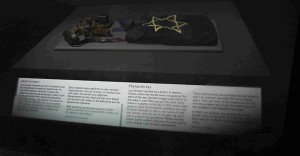“Axis of the Holocaust” is the designation of one of three corridors in the museum’s basement. Display cabinets are inlayed in the wall. They contain photographs, pieces of writing, and objects that convey the stories of people who survived or were murdered in the Holocaust.
They contain photographs, pieces of writing, and objects that convey the stories of people who survived or were murdered in the Holocaust.
In one window lie phylacteries and a pouch with an embroidered Star of David. These objects belonged to Leo Scheuer. He gave them to the museum shortly before his death.
When I read the records on Leo Scheuer in the archive of our museum, I had the feeling that there was enough material there for a feature length movie. Only a few sentences fit, however, on the little plaque next to the exhibit.
Leo Scheuer spent 15 months of his life hidden in a dugout shelter. He had with him an anatomy book, a horse blanket, and the exhibited phylacteries, which he put on every day. In February of 1944 the Soviet army liberated the area from the German occupiers and Leo Scheuer as well from his hideaway. – That is what I was able to write in the exhibit’s text.
Too lengthy to fit into the tableau was that his persecution did not end with his liberation. Because he was carrying a fake passport, the Soviets thought he was a spy and summarily condemned him to death. A Jewish judge rescinded the sentence at the last moment.
Also unmentioned is the daughter of a Ukrainian farmer, on whose property Leo Scheuer hid, who later demanded compensation from him for his stay.
For 15 months he was able neither to stand upright nor to lie down. Light and air only reached him through a narrow crack. The fear of being discovered was rivaled only by the fear of suffocating. He dispatched his excrement towards the outside in his sock. However these experiences affected Scheuer’s physical and mental wellbeing is not exposed in his file – and one can hardly imagine it.
 The Holocaust Axis requires emotional involvement from the visitor. And for them to endure the feelings that arise when one takes in the stories these cabinet displays tell. Not every detail needs to be mentioned to understand the story.
The Holocaust Axis requires emotional involvement from the visitor. And for them to endure the feelings that arise when one takes in the stories these cabinet displays tell. Not every detail needs to be mentioned to understand the story.
Nonetheless: it is sometimes hard to omit so much.
Seeing the window display installed, the text printed, and the objects arranged was very satisfying. But I also felt a sense of regret that the visitor would see only a small fraction of this story. Unnecessary to mention, which feeling prevailed.
Monika Flores Martínez, Exhibitions